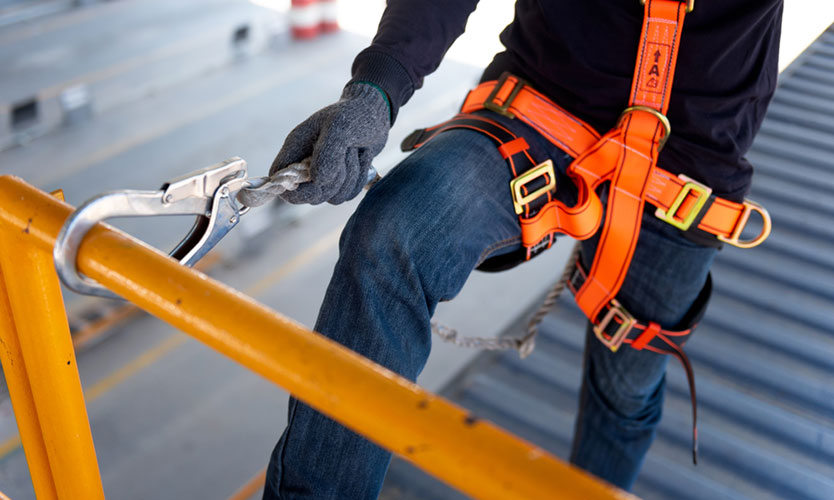Falls are a leading cause of both fatal and nonfatal injuries among workers, with 395 out of 1069 fatalities in 2022(BLS data), with repercussions that extend beyond physical harm. Families of injured workers face emotional distress and financial instability, often leading to strained relationships and altered dynamics. Elevated work areas lacking guardrails or safety systems heighten the risk, especially in poor conditions. Improper use of ladders and scaffolding, including overloading or neglecting to secure them, is another common cause.
Personal Protective Equipment (PPE) like harnesses is vital, but its effectiveness can be compromised by improper use or lack of training. Slips, trips, and falls on the same level are also significant, often due to cluttered or uneven work areas. Active planning and training are essential for mitigating these risks. Employers must conduct risk assessments, develop tailored fall protection plans, and allocate resources for equipment and training.
Employee training should focus on hazard awareness, proper equipment use, and emergency response. In addition to training, a competent person plays a crucial role in selecting equipment, identifying anchorage points, and conducting regular inspections to meet safety standards.
By addressing these causes through comprehensive safety protocols, the construction industry can reduce fall incidents and enhance workforce safety. What is a safety stand-down? The National Safety Stand-down is a voluntary program that aims to raise awareness among workers nationwide to prevent fatalities and injuries.
Purpose and Objectives of the National Safety stand-down
A Safety Stand-Down is a voluntary event where employers engage directly with employees on safety, typically focusing on “Fall Hazards” and emphasizing “Fall Prevention.” While any workplace can hold a stand-down, even those not exposed to fall hazards can use it to discuss other job hazards, protective methods, and safety policies.
It’s a platform for open communication, allowing employees to discuss concerns about safety hazards they observe. The safety standdown means its primary aim is injury prevention and workplace safety enhancement. However, it’s equally crucial to empower workers to take ownership by sharing information on OSHA standards and discussing potential solutions for compliance. By developing this dialogue, employers create a culture of safety where employees actively participate in maintaining a safe working environment.
Participation and Outreach Efforts
The success of the Safety Stand-Down centers on widespread participation and strong outreach efforts. Construction companies, contractors, trade associations, unions, and safety professionals all play pivotal roles in promoting and organizing the event. Through newsletters, social media campaigns, workshops, and site visits, stakeholders attempt to reach as many workers and employers as possible, regardless of the size or nature of the construction project.
Key Activities During the Safety Stand-Down
During the Safety Stand-Down, various activities are conducted to develop a safety culture and prevent falls. These may include:
- Toolbox Talks: Brief discussions on fall hazards, safety procedures, and incident prevention.
- Demonstrations: Practical demonstrations showcasing the correct usage of fall protection equipment and systems.
- Worksite Inspections: Comprehensive inspections to identify potential fall hazards and implement corrective measures.
- Training Sessions: Structured training programs covering safety stand-down topics such as ladder safety, scaffold usage, and proper harness fitting.
- Policy Reviews: Reviewing and updating safety policies and procedures to align with industry standards and regulations.
Target Audience: Who Should Participate?
Those who should participate in the National Safety Stand-Down event include:
- Commercial construction companies of all sizes
- Residential construction contractors
- Sub- and independent contractors
- Highway construction companies
- General industry employers
- The U.S. Military
- Other government participants
- Unions
- Employer’s trade associations
- Institutes
- Employee interest organizations
- Safety equipment manufacturers
This diverse group of participants underscores the event’s inclusive nature, welcoming anyone committed to preventing workplace hazards. The Stand-Down is a collaborative effort involving various sectors, from construction to government agencies, unions, and manufacturers. Bringing together this broad spectrum of stakeholders facilitates the sharing of best practices, develops dialogue, and promotes a collective commitment to workplace safety.
Resources and Materials Available for the Safety Stand-Down
Resources and materials available for the National Safety Stand-Down event encompass a wide array of tools and educational materials to prevent falls and enhance workplace safety. These include campaign fact sheets, posters, wallet cards, and training guides in multiple languages.
Booklets, fact sheets, and online resources provide specific guidance on fall protection, ladder safety, and scaffolding. Educational materials cover various aspects of construction safety, including aerial devices, struck-by hazards, and residential construction.
Partnerships with organizations like the Center for Construction Research and Training (CPWR), the National Institute for Occupational Safety and Health (NIOSH), and the National Safety Council (NSC) offer additional resources such as infographics, training materials, and safety articles.
The availability of free learning resources, outreach training materials, audio, and videos further supports comprehensive safety training and awareness. These resources allow employers and employees to access valuable information to enhance safety protocols and prevent workplace accidents.
Importance of Fall Prevention Training and Education
Fall prevention training and education are crucial components of safety stand-down initiatives, such as the National Safety Stand-Down promoted by OSHA. A safety stand-down is a thoughtful pause in regular work activities to focus on addressing fall hazards and emphasizing safety protocols.
- Employers can use stand-downs to educate workers about the importance of fall prevention, discuss topics like ladder safety and scaffolding, and train them on proper equipment usage.
- These events provide opportunities to share lessons learned from incidents, emphasizing the importance of vigilance and adherence to safety procedures.
- Companies demonstrate their commitment to employee well-being and injury prevention by engaging in safety stand-downs.
- Effective training and education reduce the risk of falls and empower workers to identify hazards and take proactive measures to maintain a safe working environment.
Future Directions and Continuation of the Safety Stand-Down
The future of safety stand-downs holds promise for further enhancing workplace safety across industries. OSHA Safety stand-downs are intentional pauses in regular work operations to address fall hazards and reinforce safety practices. The National Safety Stand-Down is a leading event demonstrating the significance of these initiatives. Moving forward, there’s a need for broader adoption of safety stand-downs beyond the construction sector, extending to various industries where fall hazards persist.
Topics for Safety stand-down examples can include fall prevention and other critical safety concerns, such as electrical safety, hazardous material handling, and ergonomic practices. Moreover, safety stand-downs can be integrated into safety stand-downs after incident protocols, providing a platform for comprehensive analysis and remediation after workplace accidents.
OSHA’s continued support for safety stand-downs and the establishment of resources underscores their importance in developing a safety culture. As organizations follow this concept, future directions may involve incorporating technological innovations for virtual stand-downs, ensuring participation across dispersed workforces.
Additionally, ongoing evaluation and refinement of safety stand-down practices will be essential to maximizing their effectiveness in reducing workplace injuries and fatalities. By prioritizing safety stand-downs as an active measure, companies can strive towards continuous improvement in workplace safety standards.
Conclusion
In conclusion, the National Safety Stand Down initiative has been instrumental in raising awareness and developing a culture of safety across industries, particularly in preventing falls in construction. By deliberately pausing work activities, employers engage directly with employees to address fall hazards, reinforce safety protocols, and provide training and education on proper equipment usage.
Moving forward, there is a need for broader adoption of safety stand-downs beyond construction, incorporating various industries and addressing diverse safety concerns. Safety stand-down examples of future topics may include electrical safety, hazardous material handling, and ergonomic practices. By prioritizing safety stand-downs as proactive measures, companies can continue to enhance workplace safety standards and empower employees to maintain a safe working environment.

